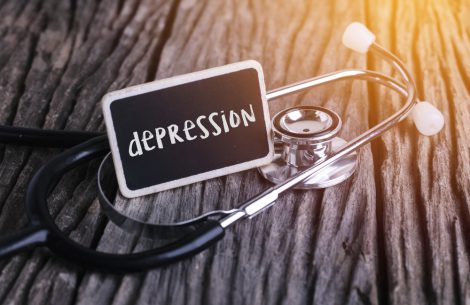Depression is a common mental disorder. In a national survey in the USA, about 1 out of every 6 adults will have depression at some time in their life. It could be handled with Chinese herbs.
According to a systematic analysis for the Global Burden of Disease Study 2013, major depressive disorder (MDD) was of the top ten causes of years lived with disability (YLDs) in every country.
The treatments for MDD
The treatments for MDD include pharmacotherapies such as selective serotonin reuptake inhibitors (SSRIs), serotonin and noradrenaline reuptake inhibitors (SNRIs), agomelatine, bupropion, mirtazapine and vortioxetine, etc., and psychological therapies such as cognitive-behavioral therapy (CBT), interpersonal therapy (IPT), and behavioral activation (BA), etc.
However, a variety of side effects from antidepressants and various difficulties in following psychosocial interventions have caused low compliance to the treatments and high relapse rates of MDD.
The famous STAR*D study conducted in the US found that more than half of all patients recruited through primary care and psychiatric clinics did not achieve remission after first-line antidepressant treatment, and 33% did not experience remission after four courses of short-term treatment (Rush, 2006).
Little notable progress in the development of drugs to treat depression has been made over the last few decades. The new, improved therapeutic approaches to deal with depression and improved safety profiles have become the target of next-generation antidepressants.
Records of Chinese herbs treating Depression
CHM has been used for the treatment of depression in China for thousands of years. The discussions about depression can be traced back to the book – Huangdi Neijing (The Inner Canon of Huangdi).
In the Eastern Han Dynasty, Jingui Yaolue (Synopsis of Prescriptions of the Golden Chamber) first described the symptoms of lily disease, globus hystericus, and “zangzao” syndrome, which are thought to be depressive syndrome. This book also recorded “banxia houpo” decoction and “ganmaidazao” decoction, both used very frequently for depression now. In Yi Xue Zheng Zhuan of Ming Dynasty, “Yuzheng”, meaning “depressive syndrome” was first recorded.
Traditional Chinese Medicine (TCM) theory for MDD and treatment
In TCM theory, there are eight common syndromes involved in depression, including qi-deficiency, blood-deficiency, yin-deficiency, yang-deficiency, qi-stagnation, fire-heat, phlegm-dampness and blood stasis.
The core of disease location of depression is liver and is closely related to spleen, kidney, and heart. Top four commonly studied TCM patterns: liver qi depression, liver depression and spleen deficiency, dual deficiency of the heart, and spleen and liver depression and qi stagnation (Yeung, 2015).
The main treatment methods are soothing liver and regulating qi, together with replenishing qi to invigorate spleen, activating blood to resolve stagnation and reducing phlegm to resolve masses (Wang, 2017).
Common Chinese Herbs treating depression, MDD
Numerous CHFs have been used for depression and tested in clinical studies. A systematic review of 296 randomized controlled trials (RCTs) found the most commonly prescribed formulae were as follows: Xiaoyao San, Chaihu shugan san, Ganmai dazao tang, Guipi tang, Wendan tang, Banxia houpu tang, Jiawei xiaoyao san, Chaihu jia longgu muli tang and Xiaobuxin tang (Yeung, 2014).
Each formula contains more than 3 herbs. For an example, Xiaoyao San is comprised of Chaihu, Danggui, Shaoyao, Bohe, Fuling, Shengjiang, Baizhu, and Gancao.
Different herbs in a formula are chose based on “sovereign, minister, assistant, courier” rule and the seven methods in prescription compatibility, in that their effectiveness in the treatment of depression becomes apparent (Feng, 2016).
Chinese herbal medicine has become an alternative treatment for depression, especially for treatment-resistant depression.
Promising results including greater efficacy and fewer side effects have been reported in hundreds of RCTs, even limitations in methodology and reporting were revealed (Butler, 2013).
Further studies on a particular formula such as Xiaoyao San in modern TCM technology is needed.
References:
- Feng Dan-dan, et al. “Nine traditional Chinese herbal formulas for the treatment of depression: an ethnopharmacology, phytochemistry, and pharmacology review.” Neuropsychiatric Disease and Treatment, Vol. 2016, pp.2387-2402.
- Rush AJ, Trivedi MH, Wisniewski SR, et al. “Acute and longer-term outcomes in depressed outpatients requiring one or several treatment steps: A STAR*D report.” Am J Psychiat, Vol, 2006;163(11), pp.1905–1917.
- Wang Yuan-yuan, et al. “Chinese Herbal Medicine for the Treatment of Depression: Applications, Efficacies and Mechanisms.” Current Pharmaceutical Design, Vol. 23, 2017, pp., 5180-5190.
- Yeung Wing-Fai, et al. “A systematic review on the efficacy, safety and types of Chinese herbal medicine for depression.” J Psychiatr Res, Vol. 57, 2014, pp.165-75.
- Yeung Wing-Fai, et al. “Prescription of Chinese Herbal Medicine in Pattern-Based Traditional Chinese Medicine Treatment for Depression: A Systematic Review.” Evidence-Based Complementary and Alternative Medicine, Vol.2015, pp. 1-12.

